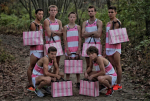sucked in from the sidelines wrote:
Making "claims" about other schools?
The only claim I saw the guy makes was that it's an advantage for teams that can have 7th and 8th graders training and racing with them. Not a "claim", it's a fact.
Also, it's pretty obvious that it makes the team stronger.
And, even if you have a club in which kids can attend in grade 7 and 8, it's a lot different than having them every day in a school program.
Geez, obviously it helps. Relax, NY is still great, the NY runners are still great, FM is still the best, nobody disputes any of that.
I'm not from FM or NY. I'm from a state where Soles would be sanctioned for coaching his team out of season.
He has claimed a special deal for NY teams, that middle schoolers train with FM, and that NY championships won with middle schoolers are tainted. Meanwhile, there has been conflicting info on what his off season access to his team and to middle schoolers is. It would help if he cleared that up. He has said if he had 100% access, the results would be different. Well, what kind of access does he currently have? If he wants a conversation he should share those facts. He also should support his claim that special rules are in place for NY teams.
why he went public with this when he has unique access to the folks at Nike who actually make the decision is beyond me.
As Bill Meylan points out, NY administrators have made a decision for their state about what is appropriate for their middle school athletes. CA has made a different decision. That does create differences, but no greater than the decision of school districts in some states to erect high schools numbering close to 4000 kids while others opt for 1500.




